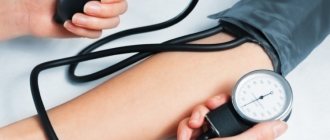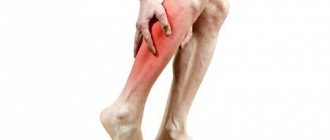Doctors Cost
Price list Doctors clinic
Treatment of dizziness in elderly patients is a complex task, which can be accomplished by a team of experienced doctors at a multidisciplinary clinic equipped with modern equipment. This disease is a consequence of various changes in the body that occur when organs and systems are damaged. Therefore, the approach to the disease must be comprehensive.
For reference:
An elderly person in Russia is considered to be a man aged 61–75 years old and a woman aged 56–75 years old.
Vertigo syndrome
Dizziness, or vertigo (from the Latin “vertigo”), is a condition in which a person in a stable position notices the illusion of movement of objects around him. In young people, vertigo may be the only symptom; in older people, it is usually accompanied by other symptoms: hearing loss, ringing in the ears, nausea, vomiting, and weakness in the legs. The severity of vertigo varies significantly - from insignificant to catastrophic. Severe dizziness in an elderly person, if left untreated, can lead to complete disorientation, incoordination, falls and injuries, and panic disorders.
Rating of drugs for dizziness
The list of tablets for dizziness was compiled by experts, primarily taking into account the recommendations of medical specialists. Based on this, 5 categories of topical medications were identified - for pregnant women, the elderly, in the case of osteochondrosis, disorders of the cardiovascular system or vestibular system. Next, each applicant was assessed on a group of criteria:
- Composition – active component, its pharmacological properties;
- The principle of operation is to influence the cause of vertigo;
- Release form - tablets, dragees, capsules, solution, syrup, etc.;
- Ease of use – scheme, duration of the course;
- Risks – toxicity, likelihood of side effects;
- Restrictions – age, contraindications, pregnancy, lactation, etc.;
- Efficiency – speed of action, period of preservation of the result;
- Sale - by prescription, free.
From several hundred suitable medications, we were able to select the top offers for 2021 based on demand and demand. The opinions of doctors, the results of clinical studies, and patient reviews significantly narrowed the search range. As a result, experts named 10 nominees in 5 categories.
The best anti-nausea pills
Development mechanism
Several systems help a person navigate space and stay in balance:
- vestibulocochlear organ, visual and proprioceptive systems;
- Nerves connecting peripheral analyzers with brain structures;
- Central nervous system (CNS or brain and spinal cord).
If any of these systems fail, vertigo develops.
The best drugs for dizziness with disorders of the vestibular apparatus
Violation of the vestibular apparatus also requires taking pills for nausea and dizziness. Their main task is to influence special histamine receptors that are located in the vessels of the inner ear. It can be taken once in case of long trips in transport, or as a course for maximum therapeutic effect. The top rating of 2021 presented 2 drugs in this category.
Dramamine
The active substance in the composition is dimenhydrinate, which inhibits the increased activity of the vestibular apparatus analyzer. As a result, taking the tablet suppresses nausea, the urge to vomit with all the ensuing consequences, and gives a moderate antiallergic effect. Most often, Dramamine is used to prevent motion sickness on airplanes, vehicles, and ships; for this, it is important to take the tablet an hour before travel. Doctors prescribe tablets for a course of treatment for Minière's syndrome, epilepsy, and other vestibular pathologies. Age limit: from 1 year of age; use in the first trimester of pregnancy is not recommended.
Advantages
- Performance;
- Prevention of motion sickness;
- One-time, course admission;
- Over-the-counter sale;
- Minimum restrictions;
- Children allowed;
- Inexpensive.
Flaws
- Possible side effects;
- Causes drowsiness.
The tablets not only calm the vestibular apparatus, but relieve muscle tone in all internal organs and prevent motion sickness in any type of transport. The advantages include quick help within 15 minutes, minimal restrictions, and price. The weaknesses of this treatment are drowsiness and the presence of side effects.
Relanium
A modern second-generation anxiolytic drug belonging to the group of tranquilizers. Most often prescribed by doctors for muscle spasms, nervous strains, anxiety disorders, as well as in various cases of damage to the cervical spine. The active component in the composition is diazepam, which enhances the effect of the inhibitory neurotransmitter, on which the transmission of nerve impulses directly depends. Widely used in medicine as a muscle relaxant, hypnotic, and sedative. There are no age restrictions; Relanium is prohibited for use during pregnancy and lactation. Available in the form of an injection solution.
Advantages
- Removing mental and nervous excitement;
- High efficiency;
- Emergency help;
- Sedative, hypnotic effect;
- Children allowed;
- Relieving cramps;
- Inexpensive.
Flaws
- May be addictive;
- Sale by prescription.
In medical practice, Relanium is used in emergency cases when it is necessary to quickly relieve attacks of nervous and mental agitation. Course treatment is also practiced, but strictly under the supervision of a doctor.
Among the advantages, reviews emphasize speed, high efficiency, calming and hypnotic results. The disadvantage is considered to be sale only under a prescription, the risks of developing addiction.
Systemic dizziness in the elderly. Causes and treatment
The condition is associated with damage to one or more systems, which is why it got its name. In people over 60 years of age, several systems are often affected simultaneously. The clinical picture and the recommended treatment regimen depend on the level of impairment.
There are peripheral and central vertigo.
Table 1. Some diseases accompanied by peripheral vertigo
| Diagnosis | Symptoms |
| Meniere's disease | Attacks are accompanied by hearing loss, nausea, tinnitus |
| Benign paroxysmal positional vertigo (BPPV) | Vertigo occurs when turning or tilting the head and lasts less than a minute. |
| Vestibular neuronitis | Severe rotational vertigo with loss of balance, vomiting, nausea. Often a complication of ARVI. |
| Perilymphatic fistula | Develops after injury, chronic otitis. An attack is provoked by changes in pressure and loud sounds. |
| Labyrinth infarction | Combined with tinnitus or one-sided deafness. |
Dizziness in the daily practice of a doctor
The problem of diagnosing and treating vestibular disorders is one of the most pressing in modern medicine, which is determined by the high incidence rate and insufficient effectiveness of existing treatment methods. Among the reasons for visiting doctors of various specialties, it is 3–4% and 10%, respectively, to otolaryngologists and neurologists [1]. In a survey of more than 20 thousand people aged 18 to 64 years, it was found that over the past month more than 20% have experienced dizziness, of which more than 30% have suffered from dizziness for more than 5 years [2]. The prevalence of dizziness in the population is about 25%, and among the elderly - 80% [3].
Dizziness is divided into vestibular and non-vestibular, otherwise it is interpreted as systemic or non-systemic. It is known that systemic dizziness is associated with irritation of certain areas of the vestibular analyzer and, depending on the level of damage, can be peripheral or central. Peripheral vestibular vertigo (vertigo) occurs when the sensory elements of the ampullary apparatus and vestibule, vestibular ganglion and nerve conductors of the brain stem are damaged. Central vestibular vertigo occurs when there is damage to the connection with the vestibular nuclei in the brain stem, disruption of connections with the cerebellum, medial longitudinal fasciculus, oculomotor nuclei and their own connections, disruption of the vestibulospinal and vestibuloreticular connections (tract), as well as connections with the cerebral cortex [4] .
The most common cases of systemic dizziness can be divided into three groups:
1) dizziness accompanied by hearing loss; 2) dizziness not accompanied by hearing loss; 3) dizziness with central neurological symptoms [5].
In the event of acute rotational vertigo, it is important to exclude life-threatening conditions - cerebral circulatory disorders in the vertebrobasilar arterial system, the symptoms of which vary and depend on which artery is occluded.
In patients with lesions in the inferior cerebellar artery, isolated rotational vertigo with fluctuating hearing loss and/or tinnitus, simulating an attack of Meniere's disease, may be observed 1–10 days before the development of cerebral infarction. Typically, dizziness during a stroke in the vertebrobasilar arterial system is combined with other neurological symptoms. However, a small lesion in the area of the cerebellar nodule or patch, the area of the exit of the VIII nerve root between the pons and the medulla oblongata, and/or the vestibular nuclei can cause isolated vertigo without accompanying manifestations. Less commonly, such symptoms can occur with damage to the dorsal insular cortex of the flocculus, and in the latter case, gaze-induced nystagmus develops [6].
The most common signs of central damage to the vestibular system are: 1) vertical nystagmus; 2) nystagmus, changing direction; 3) atypical nystagmus (especially downward) in the head shaking test; 4) asymmetric oculomotor dysfunction; 5) severe postural instability with falls. Most of these symptoms have high specificity but low sensitivity [7].
One of the tools for the differential diagnosis of central and peripheral vertigo is the Halmagi test (head impulse test) and the head shaking test, identifying vertical squint deviation (skew deviation), not associated with damage to the oculomotor nerves or their nuclei [8].
The combination of a negative Halmagi test, vertical strabismus (skew deviation), changing the direction of nystagmus and a violation of smooth vertical tracking allows us to diagnose cerebrovascular accidents in the brain stem with 100% sensitivity and 90% specificity. The head rotation test is significant for lesions in the posterior cerebellar artery basin, but has limitations and can be positive in case of blockage of the anterior cerebellar artery with the formation of a focus in the cerebellar flocculus, vestibular nuclei or the exit zone of the VIII nerve [9–12].
According to various authors, indications for neuroimaging in patients with isolated rotational vertigo are:
1) old age; 2) the presence of risk factors for vascular diseases in combination with a normal head rotation test; 3) gaze-induced nystagmus, changing direction; 4) severe ataxia with falls; 5) a combination of acute dizziness with a first-time headache, especially of the occipital localization; 6) the presence of risk factors for vascular diseases in combination with acute hearing loss [13, 14].
Clinical example 1. Patient V., 42 years old. She went to the clinic with complaints of attacks of rotational dizziness lasting up to 2–3 hours, with a feeling of objects being displaced from right to left during an attack; occur suddenly, for no apparent reason. Before an attack of dizziness, there is a feeling of “fullness” in the left ear, which disappears soon after the dizziness stops. She reported three such attacks in total.
7 months ago I consulted a neurologist with complaints of moderate noise in the left ear and slight hearing loss, which arose suddenly, against the background of complete health. Pure-tone audiometry was performed - sensorineural hearing loss of the 1st degree. After the treatment (choline alfoscerate, B vitamin complex, deproteinized hemoderivative of calf blood), she noted a complete regression of the noise; audiometry control was not carried out.
On examination there are no neurological symptoms, vestibular function at rest is compensated. Magnetic resonance imaging of the cerebellopontine angles and internal auditory canals without pathological changes. Pure-tone audiometry - increasing hearing thresholds on the left at low frequencies up to 35 dB, with a conductive component.
Diagnosis: Meniere's disease, classic form.
When making a final diagnosis of Meniere's disease, one should adhere to the modern concept of "obvious" Meniere's disease:
1) two or more spontaneous attacks of systemic dizziness lasting from 20 minutes to 12 hours; 2) audiologically confirmed hearing loss (sensorineural) at low and medium frequencies during or after an attack of systemic vertigo; 3) fluctuating auditory symptoms: hearing, subjective noise, feeling of fullness in the ear; 4) absence of other causes of systemic dizziness [16].
Acute vestibular syndrome (vestibular neuronitis and labyrinthitis) is defined by a sudden attack of intense systemic dizziness. Depending on the level of damage, hearing loss and tinnitus may occur. As a rule, the onset of symptoms is preceded by a viral illness. With these diseases, dizziness begins gradually, intensifies over several hours, and then “mild” dizziness persists for the next few days or weeks. Dizziness persists at rest, but may subjectively intensify with changes in body position. Along with dizziness, nausea, vomiting, increased sweating, and pallor are present [17].
A labyrinthine fistula is characterized by an attack of systemic dizziness or oscillopsia that occurs due to a sharp strong sound, the Valsalva maneuver, or changes in pressure in the external auditory canal, but does not depend on changes in head position [18].
Clinical example 2. Patient M., 32 years old, complains of a constant feeling of slight instability, heaviness in the head, dizziness when throwing the head back, and sometimes wakes up at night from a pronounced sensation of rotation. 3 days ago he was discharged from the neurological department, where he was diagnosed with a transient ischemic attack in the vertebrobasilar arterial system. For the first time, an attack of dizziness occurred acutely in the morning when getting out of bed, and was accompanied by palpitations, weakness, vomiting, and cold sweat. He underwent a course of treatment with vascular and neurometabolic drugs with slight improvement.
There are no focal symptoms in the neurological status. The Disc-Hallpike test on the left is a geotropic nystagmus with a rotatory component lasting 40 seconds and a latent period of 5 seconds.
Diagnosis: benign paroxysmal positional vertigo on the left (canalolithiasis of the posterior semicircular canal). After performing the Epley maneuver twice, there was complete regression of symptoms.
Benign paroxysmal positional vertigo (BPPV)
Symptoms: the occurrence of systemic dizziness when changing the position of the head: turning in bed, throwing the head back or bending forward. The duration of the episode, as a rule, is no more than a minute.
The duration of the disease varies from several days to several years, but is more often calculated in days. BPPV occurs approximately twice as often in women. With a long course of the disease, patients report changing their lifestyle and their usual actions, so as not to provoke an attack of dizziness. Many people note an imbalance in the interictal period; a number of patients experience a feeling of heaviness in the head and nausea [16].
To diagnose this condition, special positional tests are performed: Dix–Hallpike for diagnosing BPPV of the posterior semicircular canal and McClure–Pagnini for diagnosing BPPV of the horizontal semicircular canal [18]. The diagnosis of BPPV is made with a positive Dix-Hallpike test. Nystagmus that occurs during the study has a latent period of 5–20 seconds (very rarely - up to 1 minute). Dizziness and nystagmus provoked during the test decrease gradually and stop within 60 seconds. Direction of nystagmus: towards the sore ear.
If the Dix-Hallpike test is negative, it is recommended to perform a test for the lateral (horizontal) semicircular canal of McClure-Pagnini [17].
One of the most common complaints in patients with migraine (9–14%) is dizziness. It can last from a few seconds to several days, and may not be accompanied by a headache [19].
Diagnosis criteria for vestibular migraine:
1) episodic vestibular symptoms; 2) migraine according to IHS (international headaches society) criteria; 3) at least two of the following migraine symptoms occurring during an attack of dizziness: migraine headache, photophobia, sound sensitivity, or visual or other aura; 4) other causes of vestibular vertigo are excluded [19].
In the rapid diagnosis of rotational vertigo, an internist can be helped by the scheme “Acute systemic vertigo (without other neurological symptoms)” (Fig.) [20].
Treatment of acute vestibular syndrome involves the use of antiemetics and vestibular suppressants. The action of the latter is aimed at reducing the asymmetry of vestibular tone and, thus, alleviating dizziness. However, their use is limited to a few days, since the drugs slow down the formation of compensatory mechanisms in acute peripheral damage to the vestibular apparatus. The main groups of drugs used for acute dizziness: anticholinergics, antihistamines, antidopaminergics and benzodiazepines.
From the anticholinergic group, centrally acting drugs are used that act on muscarinic receptors, improving movement tolerance. The most effective is scopolamine (M3 and M5 receptors), but the duration of its use is strictly limited due to the development of dependence. Side effects: dry mouth, mydriasis, accommodation paresis, sedation, decreased reaction speed.
Among the antihistamines, H1-blockers are used, such as diphenhydramine (Diphenhydramine), cyclizine (Valoid), dimenhydrinate (Dramina), meclozine (Bonin) and promethazine (Pipolfen). The mechanism of action is based on inhibition of activation of central cholinergic connections. Additionally, they have an anticholinergic and sedative effect. Compared to anticholinergic drugs, side effects in this group are less pronounced. It should be noted that newer drugs in this group without sedation do not penetrate the central nervous system (CNS), and are therefore useless in the treatment of dizziness.
Betahistine was registered as a drug in Europe in 1970; it is a synthetic drug that has the ability to bind to H1 histamine receptors, which are located in the neuroreceptor cells of the inner ear. It has a local powerful stimulating effect, increasing the release of neurotransmitters (histamine) from the nerve endings of the receptor cells of the inner ear into the synapse. Neurotransmitters act on the precapillary sphincters, causing vasodilation of the vessels of the inner ear, increasing their permeability and thereby normalizing intralabyrinthine pressure. In addition to affecting the receptors of the inner ear, betahistine affects the receptors of the vestibular nuclei located in the medulla oblongata, reducing activity and excitability, which helps to stop dizziness.
Dopamine antagonists are used to treat nausea and vomiting in patients with acute dizziness. The antiemetic effect is due to blocking dopamine receptors in the vomiting center of the brain stem. Some antihistamines (H1-blockers), such as promethazine, have additional dopamine-blocking effects.
The action of benzodiazepines is mediated by GABA, which is a neurotransmitter that inhibits vestibular function. The most commonly used drugs are diazepam, lorazepam, clonazepam and alprazolam [21].
For more than 50 years in world medical practice, doctors of various specialties have been using the complex antihomotoxic drug Vertigoheel for the treatment of dizziness [22].
Vertigohel is a multicomponent preparation containing the pharmacologically active ingredients Anamirta cocculus, Conium maculatum, Ambra grisea and Petroleum rectificatum. Numerous studies of the mechanism of action of the drug Vertigohel suggest multi-target activity in relation to vasodilation of capillaries and thereby microcirculation.
Numerous scientific studies, including randomized clinical trials, non-interventional studies (reproducing the scheme of daily work with patients) and meta-analysis, have confirmed the effectiveness of the clinical use of Vertigoheel.
A reference controlled cohort study on 774 patients was devoted to the effectiveness and tolerability of the drug Vertigohel in comparison with dimenhydrinate for dizziness of various origins. 25 patients were prescribed the drug Vertigohel (2-3 tablets 3 times a day) or dimenhydrinate (50 mg 2-3 times a day) for a course of no more than 8 weeks. Most patients had non-vestibular vertigo (visual/somatosensory or psychosomatic disorders). Presenting symptoms also included unsteadiness in gait and standing, with a tendency to fall. The second large group was represented by patients with vestibular (systemic) vertigo with manifestations of rotational vertigo, Meniere's disease or balance disorders.
The average number of attacks, their intensity and duration decreased significantly in both groups. By the end of the course of treatment, the patients also experienced relief from accompanying symptoms: nausea, vomiting, and increased sweating. The overall result of therapy was rated as “good” or “excellent” in 88% of cases in the Vertigohel group and in 87% of cases in the dimenhydrinate group. Tolerability was rated as “good” to “excellent” in 99% of cases in the Vertigohel group and in 98% of cases in the dimenhydrinate group [23].
In the period from 2009 to 2015, we observed 89 patients aged 18 to 42 years (53 women and 36 men) with peripheral vestibular vertigo, who were recommended to take 10 drops every 15 days when acute vestibular vertigo and nausea occurred. minutes (no more than 2 hours in a row) or dimenhydrinate 50–100 mg (if necessary, every 4 hours, but not more than 400 mg per day).
All patients received both drugs, but at different time intervals. The majority of patients (83 people - 93%) rated the high effectiveness of both drugs (as "good" or "excellent"), however, all patients (89 people - 100%) noted better tolerability of Vertigohel, since the lethargy and drowsiness characteristic of dimenhydrinate did not occur .
Thus, we can recommend the use of Vertigohel to patients to relieve acute vestibular crisis at home, since the drug is highly effective and is well tolerated. Thus, Vertigohel has no known interactions with other drugs, which is especially important for the treatment of elderly patients with concomitant chronic diseases.
Literature
- Oosterveld WJ The efficacy of piracetam in vertigo. A double-blind study in patients with vertigo of central origin // Arzneimittelforschung. 2000. No. 30 (11). P. 1947–1949.
- Yardley L., Britton J., Lear S., Bird., Luxon L. Relationship between balance system function and agoraphobic avoidance // Behav. Res. Ther. 1998. Vol. 33, No. 4. P. 435–439.
- Bobrov LS, Shmyrev VI, Vasil`ev AS, Morozov SP, Rudas MS 2011, No. 1 (39). S. 115–119.
- Sheremet A. S. Dizziness as a sign of damage to the vestibular analyzer // Consilium medicum. Vertigo app. 2001. pp. 3–9.
- Burton Martin J. Dizziness: features of diagnosis and treatment // Attending Physician. 1999. No. 4. pp. 58–60.
- Savitz SI, Caplan LR Vertebrobasilar disease // N Engl J Med. 2005; 352:2618–2626.
- Lee H. Isolated vascular vertigo // Journal of Stroke. 2014; 16 (3): 124–130.
- Brodsky MC Three dimensions of skew deviation // Br J Ophthalmol. 2003, Dec; 87(12):1440–1441.
- Newman-Toker DE, Kattah JC, Alvernia JE, Wang DZ Normal head impulse test differentiates acute cerebellar strokes from vestibular neuritis // Neurology. 2008; 70:2378–2385
- Cnyrim CD, Newman-Toker D., Karch C., Brandt T., Strupp M. Bedside differentiation of vestibular neuritis from central “vestibular pseudoneuritis” // J NeurolNeurosurg Psychiatry. 2008; 79:458–460.
- Kirchner H., Kremmyda O., Hufner K., Stephan T., Zingler V., Brandt T. et al. Clinical, electrophysiological, and MRI findings in patients with cerebellar ataxia and a bilaterally pathological head-impulse test // Ann NY AcadSci. 2011; 1233:127–138.
- Park HK, Kim JS, Strupp M., Zee DS Isolated floccular infarction: impaired vestibular responses to horizontal head impulse // J Neurol. 2013; 260:1576–1582.
- Lee H, Sohn SI, Cho YW, Lee SR, Ahn BH, Park BR et al. Cerebellar infarction presenting isolated vertigo: frequency and vascular topographical patterns // Neurology. 2006; 67:1178–1183.
- Kim HA, Lee H. Recent advances in central acute vestibular syndrome of a vascular cause // J Neurol Sci. 2012; 321: 17–22.
- Lopez-Escamez JA, Carey J., Chung W.-H., Goebel JA, Magnusson M., Mandalà M., Newman-Toker DE, Strupp M., Suzuki M., Trabalzini F., Bisdorff A. Diagnostic criteria for Meniere's disease. Consensus document of the Bárány Society, the Japan Society for Equilibrium Research, the European Academy of Otology and Neurotology (EAONO), the American Academy of Otolaryngology-Head and Neck Surgery (AAO-HNS) and the Korean Balance Society // Acta Otorrinolaringol Esp . 2021, Jan-Feb; 67(1), 1–7.
- Halmagyi GM Diagnosis and management of vertigo // Clinical Medicine. 2005; 5: 159–165.
- Bhattacharyya N., Baugh, RF, Orvidas L., Barrs D., Bronston LJ, DC, Cass S., Chalian AA, Desmond AL, Earll JM, Fife TD, Fuller DC, Judge JO, Mann NR, Rosenfeld RM, Schuring LT, Steiner RWP, Whitney SL, Haidar J. Clinical practice guideline: Benign paroxysmal positional vertigo // Otolaryngology–Head and Neck Surgery. 2008, 139, S47-S81.
- Huh Y.-E., Kim J.-S. Bedside Evaluation of Dizzy Patients // J Clin Neurol. 2013; 9:203–213.
- Boldingh MI, Ljøstad U., Mygland A., Monstad P. Comparison of Interictal Vestibular Function in Vestibular Migraine vs Migraine Without Vertigo // Headache: The Journal of Head and Face Pain. Vol. 53, Issue 7, p. 1123–1133.
- Vanni S., Pecci R. STANDING, a four-step bedside algorithm for differential diagnosis of acute vertigo in the Emergency Department // ACTA otorhinolaryngologica ita lica. 2014; 34:419–426.
- Singh RK, Singh M. Otorhinolaryngology Clibics // An International Journal. 2012; 4 (2): 81–85.
- Vertigoheel is the first choice drug for dizziness. Materials from the Heel company // Pharmacist. 2002, No. 20.
- Wolschner U., Strösser W., Weiser M., Klein P. Treating vertigo - combination remedy therapeutically equivalent to dimenhydrinate: results of a reference-controlled cohort study // Biol Med. 2001; 30: 184–190.
O. V. Zaitseva1, Candidate of Medical Sciences K. V. Overchenko, Candidate of Medical Sciences A. F. Khirnetkina
FSBI Scientific Center of Otorhinolaryngology FMBA of Russia, Moscow
1 Contact information
* The drug is not registered in the Russian Federation.
Central vertigo in the elderly: causes, treatment
Associated with brain dysfunction.
Vestibular migraine.
It is characterized by attacks of dizziness with migraine-type headaches lasting no more than a day.
Impaired blood supply to the central nervous system.
Cerebral ischemia is often caused by embolic or atherosclerotic vascular lesions. This is dangerous for the development of a stroke.
Transient ischemic attack (TIA).
Associated with short-term (1 day) blockage or spasm of a blood vessel in the brain by a thrombus or embolus. With spontaneous restoration of the lumen, all symptoms disappear. Vertigo may be accompanied by nausea, numbness of one half of the face or body, weakness in the legs, and speech disorders.
Archer syndrome
caused by compression of the vertebral artery at the C1-2 level. When turning the head to the left or right, severe dizziness occurs.
Infarction or hemorrhage in the cerebellum.
Typical for elderly patients with high atherosclerotic risk, suffering from diabetes mellitus and hypertension. The disease begins acutely with dizziness, unsteady gait, and falling towards the affected side.
Multiple sclerosis.
Occurs when foci of demyelonization occur in the cerebellum. It is characterized by persistent vertigo that lasts for several weeks or longer.
Which brand of anti-vertigo medication is best to choose?
The first thing a buyer of medicines at a pharmacy looks at is the pharmaceutical company and the country of production. Using this criterion, you can already determine in absentia the effectiveness, quality, and feasibility of the purchase. The best drugs for dizziness were offered by the following imported and domestic companies:
- Ozon LLC (Betagistin) is one of the leading Russian companies in the production of medicines, operating for more than 15 years. It mainly produces decent generic analogues of patented drugs. High quality control according to GMP standards demonstrates the reliability and effectiveness of the product.
- Catalent Germany Schorndorf GmbH/Balkanpharma-Dupnitsa AD (Vestibo) is a merger of two successful pharmaceutical companies from Germany and Bulgaria. Their joint activities are based on numerous in-demand drugs for use in various areas of medical practice.
- JSC PFK Obnovlenye (Piracetam) is an industrial and research center of Russia. Collaborates with the Novosibirsk Scientific Center (Akademgorodok), and also develops new drugs that have no analogues on the domestic market. In the course of work, leading foreign partners are involved.
- Mylan Laboratories SAS (Betaserc) is a French pharmaceutical company that occupies a leading position in the production of active ingredients for the creation of drugs. It occupies a stable position not only in the domestic but also in the global market. Holds patents for some branded drugs.
- Pliva (Cerukal) is a Croatian pharmaceutical company operating since 1921. It became famous as one of the largest manufacturers of generic Adderall. It occupies a stable leadership position in Southern Europe, and within the country it ranks 3rd in terms of exports.
- JSC Gedeon Richter (Cavinton) is a large pharmaceutical research center in Central and Eastern Europe. The company was founded in Hungary in 1901. During this time, experience, rich traditions, and unshakable authority have been accumulated. In the countries of the former USSR, the products are considered one of the best.
- Pharma AD (Cinnarizine) is a Bulgarian pharmaceutical company that produces various dosage forms for fast and effective treatment with minimal risks. The product portfolio is distinguished not so much by its variety as by its prices. The drugs are actively supplied to the Russian market.
- Jadran Galensky Laboratories (Dramina) is an international pharmaceutical company that has been founded in Croatia since 1981. First, she took a leading position in the national pharmaceutical market, then expanded into the countries of the USSR and Eastern Europe. Today it is famous for its high-quality drugs in most countries of the world.
- Polfa JSC (Relanium) is a Warsaw pharmaceutical plant that has been exporting medicines for over 60 years. For many years, buyers have associated it with high quality and competitive prices. Founded in 1889, since 2010 it has been part of the ADAMED group.
- Arnebia (VertigoHel) is a brand of herbal medicines owned by the Heel brand. The catalog of homeopathic remedies includes vitamins, dietary supplements, microbiological preparations, and cosmetics. The basis is based on valuable and rare natural components.
Non-systemic dizziness in the elderly. Treatment
It is also called imaginary or false vertigo, since there is no characteristic damage to anatomical structures. However, it bothers up to 20% of patients over the age of 50 years.
Pre-fainting state.
Lasts a few seconds before fainting occurs. Caused by a sudden disruption of the blood supply to the brain caused by a spasm or another reason. Symptoms go away if you immediately sit or lie down.
Orthostatic vertigo.
Appears during a sharp transition from a horizontal to a vertical position, when getting up from a chair after eating. Caused by changes in blood pressure and cerebral ischemia.
Persistent postural-perceptual dizziness (PPVD)
, which was previously called psychogenic. Patients experience a feeling of excessive lightness or fog in the head, swaying, and non-rotational vertigo. It can last several months with periodic fluctuations in the severity of symptoms. It usually intensifies when being in crowded places, transport, watching TV or flashing pictures on a computer monitor, in enclosed spaces.
Disembarkation syndrome.
The illusion of continuing to travel on a train, on a ship, or riding a carousel, although physically the person is on a stable, flat surface.
The best drugs for dizziness during pregnancy
The review concludes with the fifth category of drugs for dizziness - drugs for pregnant women with minimal toxicity and safety for the fetus. Pregnant women often experience similar unpleasant symptoms, accompanied by nausea and vomiting. The experts considered only those medications that had undergone repeated clinical trials.
VertigoHel
A natural preparation of bioregulatory medicine, intended for absolutely any person suffering from vertigo and motion sickness. There are two release forms - tablets, drops. The composition includes many useful substances - Anamirta cocculus to normalize the functions of the vestibular apparatus and against nervous disorders, Conium against depression, cerebral sclerosis, Ambra to normalize the functions of the autonomic system, eliminate mental and nervous exhaustion, against depression and early aging, as well as Petroleum rectificatum against inflammation of the gastrointestinal tract. It is necessary to use VertigoHel in case of a problem of neurogenic, vascular origin, with seasickness, after concussions or traumatic brain injuries.
Advantages
- Natural composition;
- Ease of use;
- Acceptable at any age;
- Quick relief;
- Solving problems of any origin;
- Minimum contraindications;
- Low toxicity.
Flaws
- Price;
- Cumulative effect.
This is an excellent remedy for those for whom all previously listed medications are contraindicated. Buyers approve of the composition, the absence of risks, contraindications, and ease of use. Doctors often prescribe VertigoHel for prevention for pregnant women, young children, and the elderly. The downside is the need for a long course due to the cumulative effect, as well as the cost.
Main types of illness
A healthy person may become dizzy when exposed to a strong external irritant. Malaise can occur while skating or a carousel, while the human body cannot independently control the force of rotation. Dizziness can be divided into the following forms:
- Vestibular (otherwise known as vertigo). This form of dizziness is called true, in this case a person feels the movement of all objects that are near him, in some cases you can feel the movement of your body.
- Collaptoid. Occurs when there is a sudden change in body position or pressure that is applied to the head. At this moment, a person has a desire to take a horizontal pose as soon as possible.
- Age. Occurs in older people due to imbalance. In this case the symptom is not true.
- Conditions that are often confused with dizziness (severe fatigue, stress, neurological problems, etc.). In this case, the patient begins to complain of characteristic pain in the heart and fear of dizziness.
When should you see a doctor?
You should sound the alarm if dizziness becomes regular or prolonged. Get immediate help if you experience severe dizziness and unsteadiness along with the following symptoms:
- sudden headache;
- painful sensations in the chest area;
- labored breathing;
- numbness or weakness of the limbs;
- fainting;
- fast or intermittent heartbeat;
- slow or slurred speech;
- problems with coordination;
- continued vomiting;
- convulsions;
- sudden hearing loss;
- numbness or facial asymmetry.
Which drug for dizziness is best to buy?
The choice of any medicine is always an individual decision based on the opinions of a medical specialist. Only after an examination, determining the cause of dizziness, the characteristics of the body, can you decide unambiguously what to buy at the pharmacy. The best drug will be different for each patient. A comparative analysis of the nominees revealed the following:
- Cinnarizine is a remedy for elderly people with cardiovascular disorders;
- VertigoHel is the safest homeopathic medicine for pregnant women;
- Vestibo – high bioavailability against vertigo due to osteochondrosis;
- Relanium is a universal remedy for problems of any origin;
- Dramamine is the people's choice, the most popular medicine for motion sickness;
- Piracetam is a nootropic for stabilizing the psycho-emotional background in children and adults.
Each nominee presented in the expert rating has unique advantages and weaknesses. Based on a comparison of these data, as well as taking into account your health status and doctor’s recommendations, making a choice will not be difficult.










